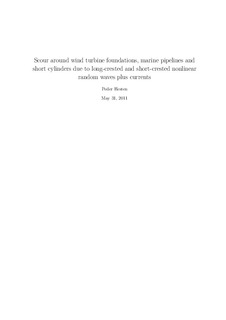Scour around wind turbine foundations, marine pipelines and short cylinders due to long-crested and short-crested nonlinear random waves plus currents
Master thesis

View/
Date
2011Metadata
Show full item recordCollections
- Institutt for marin teknikk [3472]
Abstract
This report presents a stochastic method for predicting scour depth around vertical circular slender piles, including various cross sections and group arrangements, marine pipelines and the burial and scour hole geometry around short cylinders due to long-crested (3D) and shortcrested (2D) nonlinear random waves plus current. The waves are assumed to be stationary narrowbanded and the Forristall (2000) distribution of wave crest heights representing 2D and 3D random waves is employed including both sum-frequency and difference-frequency effects. The wave crests are assumed to be responsible for the scour response. The results for scour and burial around the various structure types are presented graphically versus a measure of the wave action evaluated at the seabed relative to the characteristic diameter of the structure and versus a measure of the current velocity relative to the maximum horizontal fluid particle velocity at the seabed. The ratios between the scour depth predicted by 3D, 2D and linear waves are also investigated. Examples of calculation based on typical field conditions are provided. Due to the distinctive character of the Forristall distribution, all the results are specifically given by the seastate and the characteristic structure diameter. There are several similarities in the ratios of the scour depth for the various structures. Overall, 3D and 2D waves will produce more scour and burial than linear waves. This is due to higher fluid particla velocity under the wave crests for 3D and 2D waves compared to linear waves. In deep water, the scour depth from 2D waves is largest and in finite water depth the scour depth from 3D waves is largest. This is due to larger sum-frequency effects for 2D waves compared to 3D waves in deep water and smaller difference-frequency effects for 3D waves compared to 2D waves in finite water depth.